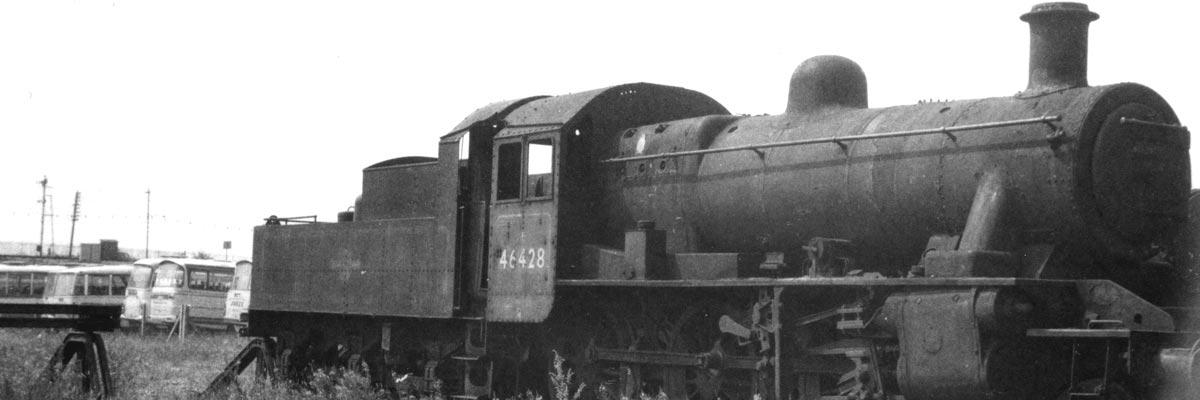Bury Standard 4 Group - Restoring 80097 and 46428
become a supporter, see how you can help learn more...
Browse now and find out more, and support us today.
Your basket is empty
Bury Standard 4 Group - Restoring 80097 and 46428
become a supporter, see how you can help learn more...
Your basket is empty

The London, Midland and Scottish Railway (LMS) Ivatt Class 2 2-6-0 is a class of steam locomotive designed for light mixed traffic.
Elderly 0-6-0s formed the backbone of the low-powered locomotives within the LMS fleet. William Stanier had concentrated on introducing larger engines and it was left to George Ivatt to introduce a new class of low-powered locomotive. He designed a tender version of the Ivatt Class 2 2-6-2T, introduced at the same time, which was inspired by the Stanier 2-6-2T which was inspired by the Fowler 2-6-2T. The 2-6-0s, with their greater range (3,000 gal of water and 4 tons of coal compared to the tank design’s 1,350 gal and 3 tons), were well-suited to their task and, following attention to draughting problems by both Derby and Swindon, quickly became a success. Further engines of this type were built as the BR standard class 2 2-6-0, these locomotives having BR standard fittings and a modified cab and tender profile to allow completely unrestricted route availability; both LMS and BR 2MT moguls are often referred to by the affectionate nickname “Mickey Mouse”.
A total of 128 were built between 1946 and 1953, mostly at Crewe. 20 were built by LMS and given the numbers 6400–19. On nationalisation in 1948 40000 was added to their numbers to become 46400–19. The remaining 108 locomotives of the class, numbered 46420–46527 were built by British Railways and from 46465 (Darlington, 1951) an increase in cylinder diameter of 1/2 inch yielded a tractive effort of 18,510lb, 1,100&lb greater than the original design. The LMS classified them 2F, BR as 2MT.
The 38 members of the Darlington-built batch (46465 to 46502) were allocated to the Eastern and North Eastern Regions of British Railways. The final 25 (46503 to 46527) were built at Swindon Works and, being allocated to the Western Region, consequently carried the GWR-type vacuum ejector and firehole doors.
The Swindon locomotives were turned out, initially, in lined black. Under the Hanks regime, some received lined green livery as they passed through works. The rest carried black livery. None of the Class was named in service, however some have been named in preservation.
The class was withdrawn between 1961 and 1967.
Seven of the class have been preserved; These are 46428, 46441, 46443, 46447, 46464, 46512 and 46521.
Several 00 gauge ready-to-run models of the locomotive have been produced. From the 1970s, Hornby Railways produced a model of the class, which was available in either British Railways green (passenger) or lined black (mixed traffic) liveries. In 2007 Bachmann Branchline introduced a more detailed model, also available in several liveries. Graham Farish have just released an early production picture of an up-and-coming N scale model. Comet Models produce an all-metal kit.
No. 46521 appeared in the sitcom Oh, Doctor Beeching! It was for this that it received the name ‘Blossom’.
Both 46443 and 46521 appeared in a film version of The Seven-Per-Cent Solution. For this role both locomotives were heavily disguised to have a European flavour.
Both “Oh, Doctor Beeching!” and “The Seven-Per-Cent Solution” were filmed on the Severn Valley Railway.
In the 2008 film adaption of Why Didn’t They Ask Evans?, an Ivatt engine can be seen pulling an express train.
Christopher Awdry had meant to write about one of the LMS Ivatt Class 2’s into the 39th book of the Railway Series as Barry the Rescue Engine,[citation needed] but was pushed aside by the publishers to celebrate the 50th anniversary of the books with the publication of Thomas and the Fat Controller’s Engines